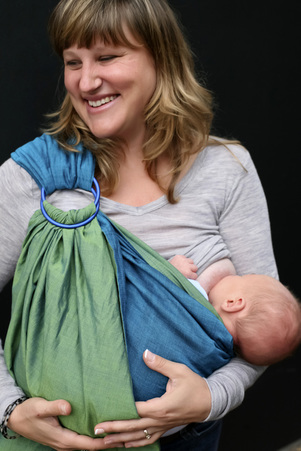 Used under the Creative Commons license through Flickr. Photography by hugabub Used under the Creative Commons license through Flickr. Photography by hugabub "I've heard you can breastfeed while babywearing. Tell me what I need to do!" Feeding while wearing is a very common topic. Babies spend an awful lot of their young lives eating! It is technically possible to feed a baby in just about any type of carrier. However, it is often a skill that must be learned and practiced, by both wearer and baby, so it is not as easy as one might hope. A number of factors can affect how quickly you might learn this skill, or what carriers might work for you, including breast shape and size, body type, and baby's feeding position preferences. Here are some guidelines that will hopefully help you learn this skill. Safety first! Open Airway: Make sure baby can breathe, and his face is not covered by the carrier or pressed into your breast tissue, if you are breastfeeding. Listen while he eats, for any unusual sounds like grunting, snoring, or other atypical feeding noises. These can signify he is having problems breathing and needs to be repositioned (don't forget to check to be sure his chin is off his chest). Visible: If you use part of the carrier (perhaps the tail of a ring sling), or a blanket or cover for privacy, cover yourself but do not cover baby's face. If his face is covered, he is re-breathing the air he exhales which can be very dangerous. Close enough to kiss: Do not keep baby in the (usually lowered) breastfeeding position after he is done breastfeeding, even if he is asleep. Move him back up to the higher, upright "visible and kissable" position, and re-adjust the carrier. First Steps Ensure that you learn and refine each skill (feeding/breastfeeding, and babywearing) separately and are competent at each, before you combine them. The breastfeeding relationship should be well-established, with good latch and transfer of milk. A very new baby might sleep deeply while in a carrier and miss feedings, so be aware of your baby's feeding needs. Clothing (for breastfeeding) This all depends on your preference. Many mothers prefer a shirt with a neckline that allows them to lift the breast over the top. Others prefer the "two shirt" method, and with a carrier, you will want to lift the top shirt a bit as you are putting the carrier on (otherwise, the top shirt may get caught in the carrier, making it difficult to lift). Expectations You should know that you will likely not be hands free feeding for a while, even with baby in the carrier. You will probably have a hand supporting your baby's head (especially if baby is young), and possibly have another hand supporting your breast. If you are using bottles, you will have to use a hand to hold the bottle. Over time, as your baby grows, and with practice, you may gain a hand or two back. The biggest gain you'll get is the ability to move and feed without bearing baby's full weight in your arms. Mechanics For breastfeeding: In most every carrier, you will lower the baby by loosening the carrier a bit and sliding baby down your body, until baby's head is at breast level. It is also possible to breastfeed with baby in a slightly reclined position, but this can make repositioning baby afterwards a bit more complicated. For bottlefeeding: Generally, it works well to reach a hand under a strap (for buckle carriers or mei tais) or pass (for wraps) and grasp the bottle, then feed. If baby prefers to eat in a specific position, you can shift them in the carrier to be in this position, remembering to reposition when baby is done. Videos: Breastfeeding in the Ergo. (Similar to how you'd feed in a Tula, Bjorn, Boba, etc). Breastfeeding in a wrap. Breastfeeding in a mei tai. Breastfeeding in a ring sling. If you would like some in-person assistance with learning this skill, please attend a local babywearing group meeting, or contact a babywearing educator for private and personalized help. If you do not have access to either of these resources, consider asking at a breastfeeding group, keeping in mind the safety information discussed above. Sources: http://www.bwiaustin.org/breastfeeding-while-babywearing/ http://beltwaybabywearers.blogspot.com/2011/06/babywearing-triplets-feeding-in-carrier
2 Comments
2/6/2023 09:31:43 am
Thanks for sharing the article, and more importantly, your personal experience of mindfully using our emotions as data about our inner state and knowing when it’s better to de-escalate by taking a time out are great tools. Appreciate you reading and sharing your story since I can certainly relate and I think others can to
Reply
2/6/2023 10:03:40 am
Thanks for sharing the article, and more importantly, your personal experience of mindfully using our emotions as data about our inner state and knowing when it’s better to de-escalate by taking a time out are great tools. Appreciate you reading and sharing your story since I can certainly relate and I think others can to
Reply
Leave a Reply. |
AuthorBeth. The babywearing lady. Archives
May 2017
Categories
All
all content
copyright 2016 Beth Secrist All photos used under the Creative Commons license through Flickr. Photography by: littletuesday12 |


 RSS Feed
RSS Feed